When designing professional heating systems, it is necessary to take into account all factors - both external and internal. This is especially true for heat supply schemes for multi-apartment buildings. What is special about the heating system of a multi-storey building: pressure, circuits, pipes. First you need to figure out the specifics of its arrangement.
Features of heat supply for multi-storey buildings
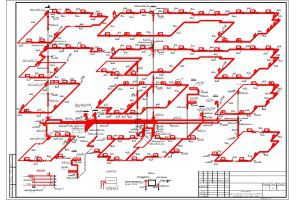
Autonomous heating of a multi-storey building should perform one function - the timely delivery of the coolant to each consumer while maintaining its technical qualities (temperature and pressure). For this, the building must be provided with a single distribution unit with the possibility of regulation. In autonomous systems, it is combined with water heating devices - boilers.
The characteristic features of the heating system of a multi-storey building are in its organization. It should consist of the following mandatory components:
- Distribution unit... With its help, hot water is supplied through the highways;
- Pipelines... They are designed to transport the coolant to individual rooms and premises of the house. Depending on the method of organization, there is a one-pipe or two-pipe heating system for a multi-storey building;
- Control and regulation equipment... Its function is to change the characteristics of the coolant depending on external and internal factors, as well as its qualitative and quantitative accounting.
In practice, the heating scheme of a residential multi-storey building consists of several documents, including, in addition to the drawings, the calculated part. It is drawn up by dedicated design bureaus and must comply with current regulatory requirements.
The heating system is an integral part of a multi-storey building. Its quality is checked during the delivery of the object or during the implementation of scheduled inspections. The responsibility for this lies with the management company.
Piping in a multi-storey building
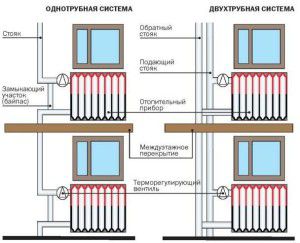
For normal operation of the heat supply of a building, it is necessary to know its basic parameters. What pressure in the heating system of a multi-storey building, as well as the temperature regime, will be optimal? According to the standards, these characteristics should have the following values:
- Pressure... For buildings up to 5 floors - 2-4 atm. If the number of floors is nine - 5-7 atm. The difference lies in the pressure of hot water to transport it to the upper levels of the house;
- Temperature... It can vary from + 18 ° C to + 22 ° C. This only applies to living quarters. On staircases and non-residential rooms, a decrease of up to + 15 ° C is allowed.
Having determined the optimal values of the parameters, you can start choosing the heating distribution in a multi-storey building.
It largely depends on the number of storeys of the building, its area and the capacity of the entire system. The degree of thermal insulation of the house is also taken into account.
The pressure difference in the pipes on the 1st and 9th floors can be up to 10% of the standard. This is a normal situation for a multi-storey building.
One-pipe heating distribution
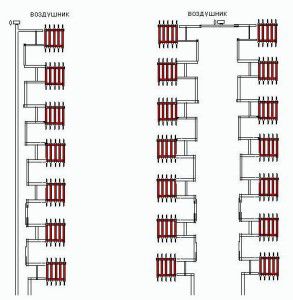
This is one of the economical options for organizing heat supply in a building with a relatively large area. For the first time, a massively one-pipe heating system of a multi-storey building began to be used for "Khrushchev" houses. The principle of its operation consists in the presence of several distribution risers to which consumers are connected.
The coolant is supplied along one pipe circuit. The absence of a return line greatly simplifies the installation of the system, while reducing the costly part. However, at the same time, the Leningrad heating system of a multi-storey building has a number of disadvantages:
- Uneven heating of the room, depending on the remoteness of the hot water intake point (boiler or collector unit). Those. options are possible when the consumer, connected earlier according to the scheme, will have batteries hotter than those of the next in the chain;
- Problems with regulating the degree of heating of radiators. To do this, a bypass must be done on each radiator;
- Complex balancing of a single-pipe heating system in a multi-storey building. It is carried out using thermostats and valves. In this case, a system failure is possible even with a slight change in the input parameters - temperature or pressure.
Currently, the installation of a one-pipe heating system for a new-built multi-storey building is extremely rare. This is due to the difficulty of individually accounting for the coolant in a separate apartment. So, in residential buildings of the Khrushchev project, the number of distribution risers in one apartment can reach up to 5. Those. for each of them it is necessary to install an energy consumption meter.
A properly compiled estimate for heating a multi-storey building with a one-pipe system should include not only maintenance costs, but also the modernization of pipelines - the replacement of individual components with more efficient ones.
Two-pipe heating system
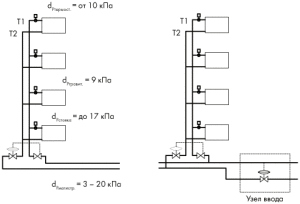
To improve efficiency, it is best to install a two-pipe heating system in a multi-storey building. It also consists of distribution risers, but after the coolant passes through the radiator, it enters the return pipe.
Its main difference is the presence of a second circuit that performs the function of a return line. It is necessary to collect cooled water and transport it to the boiler or to a heating station for further heating. During the design and operation, it is necessary to take into account a number of features of the heating system of a multi-storey building of this type:
- The ability to adjust the temperature level in individual apartments and in the entire line as a whole. For this it is necessary to install mixing units;
- To carry out repairs or maintenance work, you do not need to turn off the entire system, as in the Leningrad heating scheme for a multi-storey building. It is enough to shut off the flow to a separate heating circuit with the help of stop valves;
- Low inertia. Even with a good balancing of the one-pipe heating system of a multi-storey building, the consumer needs to wait 20-30 seconds for hot water through the pipelines to reach the radiators.
What is the optimal pressure in the heating system of a multi-storey building? It all depends on its number of storeys. It must ensure that the coolant is raised to the required height. In some cases, it is more efficient to install intermediate pumping stations in order to reduce the load on the entire system. In this case, the optimal pressure value should be from 3 to 5 atm.
Before purchasing radiators, you need to find out according to the heating scheme of a residential multi-storey building its characteristics - pressure and temperature regime. Batteries are selected based on this data.
Heat supply of a multi-storey building
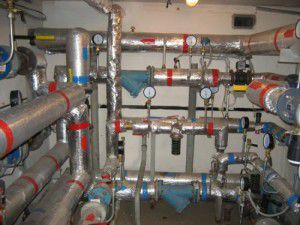
The distribution of heating in a multi-storey building is important for the operational parameters of the system.However, in addition to this, the characteristics of the heat supply should be taken into account. An important of them is the way of supplying hot water - centralized or autonomous.
In most cases, they make a connection to the central heating system. This allows you to reduce the running costs in the estimate for heating a multi-storey building. But in practice, the level of quality of such services remains extremely low. Therefore, if there is a choice, preference is given to autonomous heating of a multi-storey building.
Autonomous heating of a multi-storey building
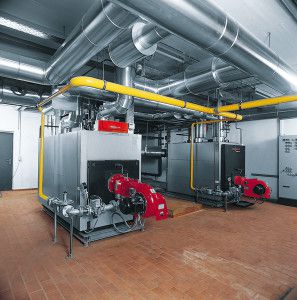
In modern multi-storey residential buildings, it is possible to organize an independent heating system. It can be of two types - apartment or general. In the first case, the autonomous heating system of a multi-storey building is carried out separately in each apartment. For this, an independent piping is made and a boiler is installed (most often a gas boiler). A common house implies the installation of a boiler room, to which special requirements are imposed.
The principle of its organization is no different from a similar scheme for a private country house. However, there are a number of important points to consider:
- Installation of several heating boilers. It is imperative that one or more of them perform a duplicate function. In case of failure of one boiler, the other must replace it;
- Installation of a two-pipe heating system of a multi-storey building, as the most effective;
- Drawing up a schedule for scheduled maintenance and preventive maintenance. This is especially true for heating heating equipment and security groups.
Taking into account the peculiarities of the heating scheme of a particular multi-storey building, it is necessary to organize an apartment heat metering system. To do this, you need to install energy meters on each incoming pipe from the central riser. That is why the Leningrad heating system of a multi-storey building is not suitable for reducing operating costs.
Centralized heating of a multi-storey building
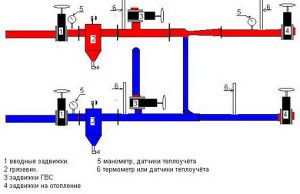
How can the heating wiring in an apartment building change when it is connected to the central heating supply? The main element of this system is the elevator unit, which performs the functions of normalizing the parameters of the coolant to acceptable values.
The total length of the central heating mains is quite large. Therefore, in the heating station, such parameters of the heat carrier are created so that heat losses are minimal. To do this, the pressure is increased to 20 atm., Which leads to an increase in the temperature of hot water to + 120 ° C. However, given the peculiarities of the heating system in an apartment building, the supply of hot water with such characteristics to consumers is not allowed. To normalize the parameters of the coolant, an elevator unit is installed.
It can be calculated for both two-pipe and one-pipe heating systems of a multi-storey building. Its main functions are:
- Reducing pressure with an elevator. A special cone valve regulates the volume of the coolant inflow into the distribution system;
- Reducing the temperature level to + 90-85 ° С. For this, a unit for mixing hot and cooled water is intended;
- Coolant filtration and oxygen reduction.
In addition, the elevator unit performs the main balancing of the one-pipe heating system in the house. For this purpose, it is provided with shut-off and control valves, which regulate pressure and temperature in automatic or semi-automatic mode.
You also need to take into account that the estimate for centralized heating of a multi-storey building will differ from the autonomous one. The table shows the comparative characteristics of these systems.
| Parameters | Centralized | Autonomous |
| Primary setup costs | Low - installation of an elevator. | High - boilers, security and control group. |
| Heat carrier costs | High rates | The ability to adjust the parameters of the coolant |
| Quality of work | Low - interruptions, temperature surges | High when installing monitoring equipment |
| Service | Low costs | average cost |
Based on the foregoing, for an apartment building, it is preferable to choose an autonomous heat supply system. However, it is necessary to pay special attention to the characteristics of the boilers and the professional drawing up of the heating scheme.
The video shows the principle of heating a multi-storey building:








and if everything was fine in a two-pipe heating system for several years, but suddenly there were noises in the pipes. aluminum batteries whine quietly and get on the nerves.
what can it be, what to do? the plumber was doing something, but things are still there.
need to blow off the air